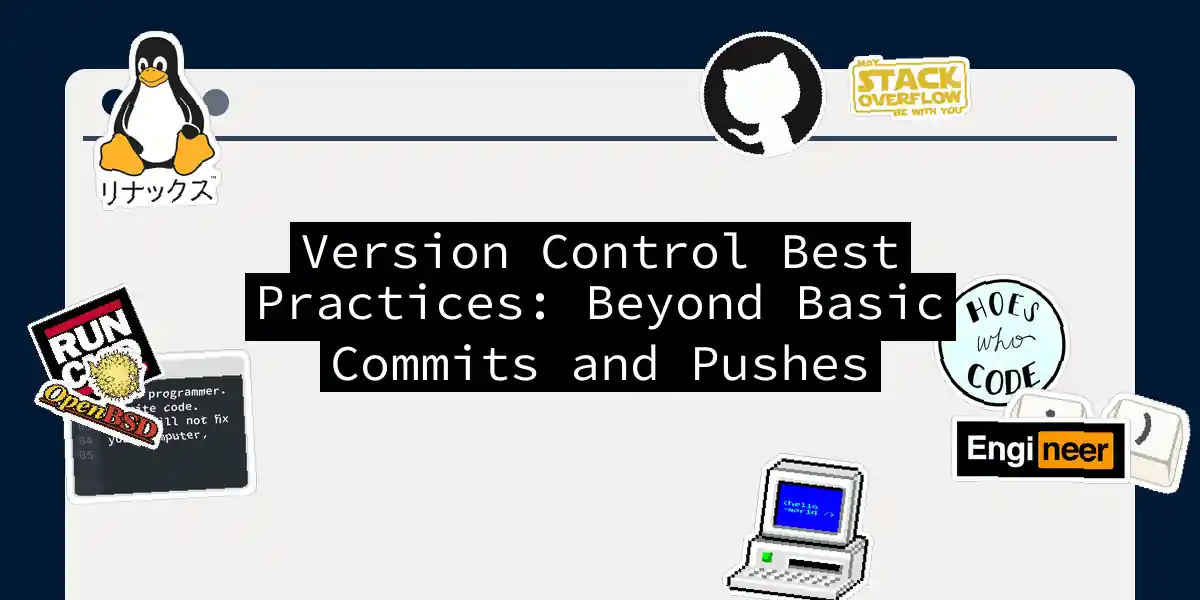Embarking on the Version Control Odyssey
So you’ve mastered git add, git commit, and git push – congratulations! You’re now officially more dangerous than a caffeinated squirrel in a server room. But like any good superhero origin story, mastering the basics is just the beginning. In this guide, we’ll explore how to transform your version control habits from “meh” to “marvelous” with battle-tested practices that’ll make your collaborators want to hug you (or at least stop cursing your name in commit logs).
🛠️ Repository Setup: First Impressions Matter
Never underestimate a clean start – a messy repo is like showing up to a black-tie event in pajamas. Here’s how to avoid that awkwardness:
- Initialize with purpose: Skip
git inituntil you’ve crafted your.gitignorefile. This unsung hero keeps digital lint out of your repo. For Node.js projects, your.gitignoremight look like this:
# Node modules
node_modules/
# Build artifacts
dist/
build/
# Environment variables
.env
.env.local
# Editor files
.vscode/
.idea/
- Branching strategy: Adopt a branching model that doesn’t resemble spaghetti code. The Git Flow method remains a classic for good reason:
✨ Commit Craftsmanship: Messages That Matter
Commit messages should tell a story, not read like ransom notes. Here’s how to elevate your message game:
- Imperative mood: Start with verbs like “Fix”, “Add”, “Refactor”
- 50/72 rule: Keep subject lines under 50 characters, body under 72
- Context: Explain why you made changes, not just what changed
Bad example: “fixed stuff” 😭
Good example: “Refactor auth middleware to support JWT expiration checks” Atomic commits are your new best friends – each commit should represent a single logical change. Splitting changes is like doing laundry: whites and colors don’t mix. Usegit add -pto interactively stage hunks:
git add -p # Review each change hunk-by-hunk
git commit -m "Implement user profile image upload"
🔄 Branch Management: Not All Branches Were Created Equal
Feature flags beat permanent branches – long-lived branches cause more merge conflicts than a family Thanksgiving dinner. Instead:
- Create short-lived feature branches:
git checkout -b feat/dark-mode-switcher
- Rebase frequently to keep up with
main:
git fetch origin
git rebase origin/main
- Squash merge for cleaner history:
git merge --squash feat/dark-mode-switcher
Pro-tip: When branches start dating (merge), do it in public with pull requests. GitHub/GitLab merge requests create accountability and documented decision trails.
🔐 Security: Guarding Your Code Castle
Accidental commits happen – like when you accidentally committed your AWS keys last Tuesday. Here’s how to avoid repeat performances:
- Pre-commit hooks: Use
pre-commitframework to block sensitive data:
- repo: https://github.com/pre-commit/pre-commit-hooks
rev: v4.0.1
hooks:
- id: detect-aws-credentials
- id: detect-private-key
- Automated scanning: Integrate tools like GitGuardian or TruffleHog in CI pipelines
- Sign your commits: Because impersonating you shouldn’t be easy:
git config --global commit.gpgsign true
git config --global user.signingkey YOUR_KEY_ID
🤖 Automation: Your Digital Butler
Manual processes are so 2010 – automate the boring stuff: Pre-push hooks that run tests:
#!/bin/sh
npm test # Fails push if tests fail
CI/CD integration that:
- Runs linters on PRs
- Blocks merges on test failures
- Auto-deploys tagged releases
🔥 Conflict Resolution: Turning Fights into Fixes
Conflicts happen – it’s like when two chefs try to season the same soup. Instead of panicking:
- Understand conflict markers:
<<<<<<< HEAD
const darkMode = true;
=======
const darkMode = false;
>>>>>>> feature/dark-mode
- Use visual tools:
git mergetoollaunches configured diff tools - Test resolutions: Never trust a merge without verification
- Prevent conflicts: Rebase early, rebase often (see a pattern here?)
🚀 Release Engineering: Launch Like NASA
Tagging isn’t just for Instagram – proper versioning prevents “works on my machine” disasters:
- Semantic versioning:
MAJOR.MINOR.PATCH - Annotated tags for releases:
git tag -a v1.2.3 -m "Official dark mode release"
git push --tags
- Release branches for hotfixes:
git checkout -b release/1.2.4
# Apply critical fixes
git tag v1.2.4
The Grand Finale: Your Version Control Jedi Checklist
Adopting these practices is like installing seatbelts in your development workflow – you might not notice them daily, but they’ll save your project during crashes:
- ✔️ Atomic commits that tell coherent stories
- ✔️ Branch hygiene with short-lived feature branches
- ✔️ Automated guardians via hooks and CI/CD
- ✔️ Signed commits for verifiable history
- ✔️ Semantic versioning for predictable releases Remember: Good version control isn’t about avoiding mistakes – it’s about making mistakes survivable. Now go forth and commit like the code whisperer you were meant to be! 🚀
